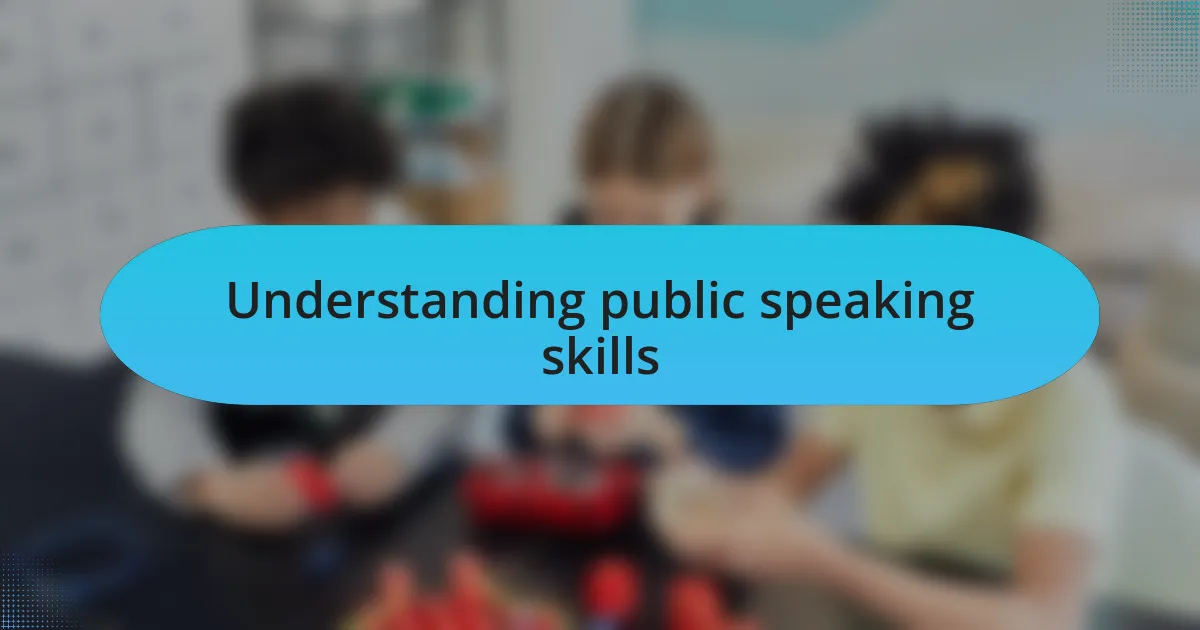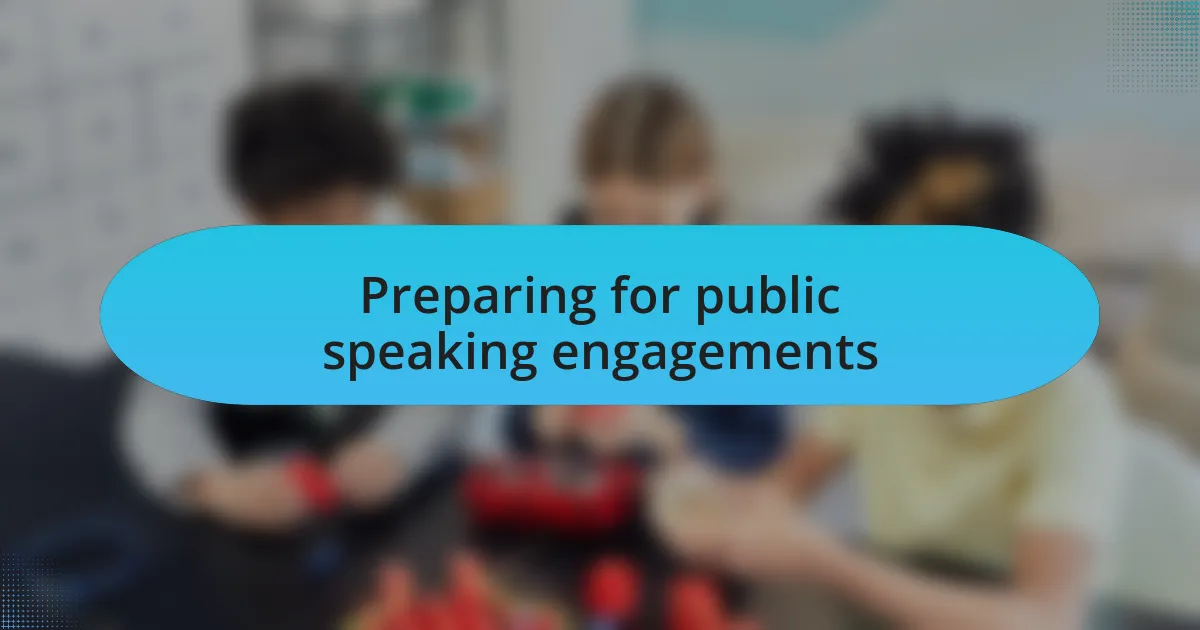Key takeaways:
- Connecting emotionally with the audience enhances public speaking effectiveness.
- Effective speech preparation involves deep understanding of the topic and rehearsal, including adjusting to the venue.
- Using personal stories and clear structure in speeches fosters audience engagement and retention.
- Authenticity, practice, and seeking feedback are crucial for continuous improvement as a speaker.

Understanding public speaking skills
Public speaking skills are the backbone of effective advocacy. I still remember my first time presenting in front of a large audience; my hands were clammy, and my heart raced. As I stood there, I realized that speaking isn’t just about the words but also about connecting with the audience on an emotional level. Have you ever felt that rush of adrenaline when sharing something you’re passionate about? That’s the moment when true communication happens.
Understanding the structure of a speech is crucial. Early on, I learned that organizing my thoughts into a clear beginning, middle, and end made a world of difference. I experimented with different formats, sometimes starting with an engaging story to draw listeners in. This technique not only grabs attention but also makes your message memorable. Isn’t it fascinating how a well-placed narrative can resonate with people long after you’ve left the stage?
Engaging your audience is about more than just delivering information; it’s about fostering a dialogue. I’ve found that asking questions can really spark interest and reflection. For instance, I often invite my listeners to think about their own experiences related to the topic at hand. By doing so, I’ve noticed how quickly the atmosphere shifts from one of passive listening to active participation. How do you think your audience might respond to being involved in the conversation? It’s a powerful tool that can enhance the impact of your advocacy efforts.

Preparing for public speaking engagements
Preparing for public speaking engagements requires more than just memorizing your speech; it demands a deeper connection with your material. I always start by immersing myself in the topic, ensuring that I truly understand its nuances and implications. Have you ever found yourself completely captivated by a subject? That deep enthusiasm translates into authority, and it helps you keep the audience engaged.
Rehearsing in front of a mirror or recording myself has become a vital part of my process. When I practiced for my last presentation, I realized how many small gestures and facial expressions I could refine. Each time I tweaked my delivery, I felt more confident. It’s fascinating how even subtle changes in body language can enhance the message. Think about how you might appear to an audience; do your actions mirror your passion for the cause?
Finally, adjusting to the venue is often overlooked in preparation. I recall the first time I spoke in a large auditorium—it was a completely different experience from practicing in my room. I wandered the space beforehand, familiarizing myself with the microphone and layout. This practice helped ease my nerves on the day of the event. How can you make your speaking environment feel more comfortable? Preparing for the unexpected can greatly enhance your performance and reduce anxiety.

Developing effective speech content
When developing effective speech content, I focus on identifying a clear message that resonates with the audience. I remember once crafting a speech on mental health awareness, where one poignant personal story became the centerpiece. It wasn’t just about sharing facts; it was about creating an emotional connection. Have you ever found a simple story impactful enough to move an audience? That’s the power of relatable content.
I also believe in structuring my speeches clearly. For instance, during a presentation on community service, I divided my speech into three main points: the problem, the proposed solution, and the call to action. This structure not only guided my audience through my thoughts but also made it easier for them to absorb the information. How do you ensure your audience can follow your narrative?
Incorporating visuals can further enhance speech content. I recall using impactful images during a discussion on environmental conservation; they generated a visceral reaction and, crucially, spurred audience engagement. I noticed that the more I connected the visuals to my words, the more invested the audience became in my message. Have you thought about how visuals might elevate your presentations? Rather than just supporting the speech, they can become vital components that enrich the overall experience.

Lessons learned from my experiences
One of the most significant lessons I’ve learned is the importance of authenticity when speaking in public. I remember standing in front of an audience, feeling the weight of my nerves, yet the moment I shared my genuine experiences, particularly one about overcoming self-doubt, the atmosphere shifted. Have you ever noticed how raw honesty can create a powerful bond? It reminded me that being real allows the audience to connect not just with my words, but also with my journey.
Another important takeaway from my advocacy efforts has been the value of practice. Early on, I delivered a speech that I thought was well-prepared, but when I stumbled over my words, it highlighted my lack of rehearsals. I realized that practice didn’t just build confidence; it ensured that my message was delivered smoothly. Have you ever felt the difference between a well-rehearsed presentation and a spontaneous one? That distinction can make or break your impact.
Lastly, I’ve learned that feedback is an invaluable gift. After one particular talk on social justice, I received constructive criticism that initially stung but ultimately led to growth. Embracing uncomfortable feedback transformed my approach and made my future speeches more impactful. Do you seek feedback after your presentations? It’s a tool that can elevate your effectiveness as a speaker beyond what you might expect.